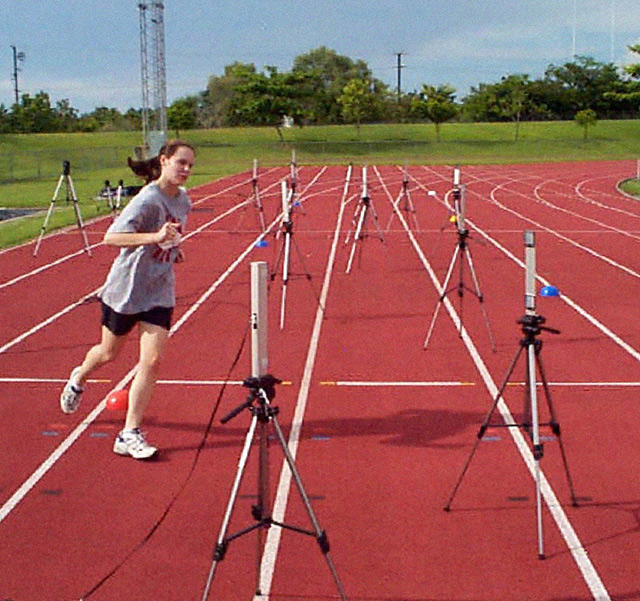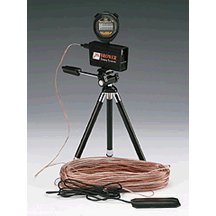This page is just information about speed timing systems in general. There is no specific product for sale - there is another page with some timing gates for sale.
Timing gates are very valuable tools for the exercise physiologist for timing measurement during fitness testing. They are most widely used for sprint testing, though many systems can be adapted for other applications such as measuring vertical jump height and reaction time.
Uses
There are several types of timing gates made specifically to measure running speed in fitness testing. Compared to the alternative of using a stopwatch, the timing gate provides an accurate and reliable measure of speed.
Using infra-red signal and detectors, the gates record when the beam is broken. Using different configurations, the gates should be able to be used for single sprint, repeat sprints, running back and forth through same gate, and multiple people sprinting in different lanes. Some systems may also come with a timing switch sensor mat to use for vertical jump testing.
Common Features
- Storage and Download: As there is often a large amount of data recorded, it is important that a timing system has the ability to store the test results which can be downloaded later to a computer for processing.
- Single or multiple beam: The timing gates may have a single beam that has to be broken to start or stop the timing. This has the advantage of being easy to set up and align the gates. However, anything passing between the gate can signal a break, such as a swinging arm during running. Gates with multiple beams can avoid this as all of the beams need to be broken at once to record a signal, which usually occurs as the torso passes through the gates. The multiple beam systems are more difficult to set up as all beams must be aligned for it to work.
- Wiring: There are both wireless and wired systems. Wireless systems enable the gates to be placed anywhere within range, and are very versatile. Systems that require wires to connect between gates can cause problems, as you are limited by the length of the wires, and the wires may get in the way if you wish to set up a complex running grid.
- Ease of setup: You may wish to avoid systems that take a long time to set up, or take more than one person to put together.
 agility test using timing gates
agility test using timing gatesReliability: You want a system that works well every time - there is nothing worse that getting a group of athletes together for testing and you spend ages trying to get the timing gate system working.
- Environmental Conditions: Some timing systems may not work in extreme temperatures (rain, heat, cold), and windy conditions may tend to blow down poorly secured or poorly balanced gates.
Related Pages
- Procedures for Sprint Testing
- Buy Timing Gates
- Photo Finish Sprint Timer Phone App
Related Products
- Optojump Next
- Chrono Jump
- Vertical Jump Testing - Jump Laser and JustJump
- Stopwatches
- Speed Radar



 Current Events
Current Events